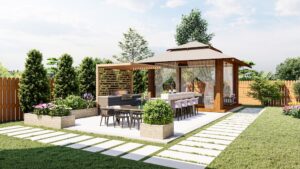Pet-Friendly Home Buying: What Every Animal Lover Should Know
 For many of us, pets are more than just animals—they’re family. When it comes to buying a home, their needs should be just as important as yours. From backyard space to local pet ordinances, making thoughtful choices for your furry (or feathery) companions ensures a smoother transition and a happier life in your new space.
For many of us, pets are more than just animals—they’re family. When it comes to buying a home, their needs should be just as important as yours. From backyard space to local pet ordinances, making thoughtful choices for your furry (or feathery) companions ensures a smoother transition and a happier life in your new space.
Here’s what to keep in mind when buying a home with your pets in mind.
1. Location, Location… Leash Laws?
Before you fall in love with a neighborhood, research local animal ordinances and HOA rules. Some communities restrict certain breeds, enforce leash laws, or limit the number of pets per household.
Tip: Look for pet-friendly neighborhoods near dog parks, walking trails, and pet-focused amenities like grooming salons or vet clinics. Petfinder offers a guide to help locate pet-accommodating communities.
2. Floorplans That Fit All Paws
When touring homes, consider how your pet will move and live in the space. Open layouts make it easier to keep an eye on your pets. Hardwood or tile floors are easier to clean than carpets, especially in high-traffic pet zones.
Bonus: A mudroom or laundry area can double as a grooming station or litter box zone.
3. The Outdoor Factor
A private, fenced yard is often a must-have for pet parents. But it’s not just about having a yard—it’s about having a safe one. Check for gaps in fencing, toxic plants, or steep terrain.
If you’re considering a condo or townhome, ask about pet relief areas or nearby green spaces.
4. Pet-Friendly Features and Upgrades
As more homeowners embrace pet-conscious living, builders and sellers are adapting. Here are some desirable features:
- Built-in feeding stations
- Under-stair pet nooks
- Pet washing stations
- Screened-in porches
- Sliding doors with pet flaps
These small design elements can greatly enhance daily life for you and your pet.
5. Stress-Free Transitions for Pets
Buying a home is already stressful—but moves can be especially hard on animals. Create a transition plan that includes:
- Keeping pets away during showings and moving day
- Setting up a quiet “safe room” in the new home with familiar toys
- Gradual reintroduction to new areas
The ASPCA recommends introducing pets to their new surroundings slowly to minimize anxiety.
6. Don’t Forget Resale Value
Even if you’re a lifelong animal lover, future buyers may not be. Pet damage—scratched floors, stained carpet, or worn landscaping—can impact home value.
Choose durable materials, maintain your outdoor space, and consider easy-to-reverse pet features for broad appeal.
In Closing: Buy Smart, Live Happy
Purchasing a pet-friendly home is a long-term investment in your family’s well-being—including the four-legged members. With a little research and planning, you can find a home that works for everyone.
Looking to make a move with your pet? Reach out to a real estate professional who understands the unique needs of pet owners.
Compliments of Virtual Results




 If you’re prepping your home for the market, you don’t need a massive renovation budget to make a meaningful impact. In fact, smart upgrades under $500 can make your home more appealing, competitive, and even more valuable in buyers’ eyes. Here are seven strategic improvements that can help maximize your home’s resale potential—without maxing out your wallet.
If you’re prepping your home for the market, you don’t need a massive renovation budget to make a meaningful impact. In fact, smart upgrades under $500 can make your home more appealing, competitive, and even more valuable in buyers’ eyes. Here are seven strategic improvements that can help maximize your home’s resale potential—without maxing out your wallet. When you first listed your home, you likely had high hopes: eager buyers, quick offers, and a smooth closing. But if your house didn’t sell, you’re not alone—and all is not lost. Many homeowners face this bump in the road. The key is to regroup, reassess, and relaunch with a smart strategy.
When you first listed your home, you likely had high hopes: eager buyers, quick offers, and a smooth closing. But if your house didn’t sell, you’re not alone—and all is not lost. Many homeowners face this bump in the road. The key is to regroup, reassess, and relaunch with a smart strategy. Adding an outdoor kitchen can elevate your backyard from a simple lounging space to a vibrant hub for cooking, entertaining, and relaxing. Whether you’re a grill master or a casual weekend host, an outdoor kitchen blends functionality with lifestyle appeal. But before firing up those built-in burners, it’s essential to understand the key planning, design, and maintenance elements that go into building the perfect alfresco culinary space.
Adding an outdoor kitchen can elevate your backyard from a simple lounging space to a vibrant hub for cooking, entertaining, and relaxing. Whether you’re a grill master or a casual weekend host, an outdoor kitchen blends functionality with lifestyle appeal. But before firing up those built-in burners, it’s essential to understand the key planning, design, and maintenance elements that go into building the perfect alfresco culinary space. Your home should be more than just a place to sleep — it should uplift your spirit, calm your nerves, and support your wellbeing. Fortunately, happiness at home isn’t about expensive renovations or picture-perfect interiors. It’s about fostering joy, comfort, and connection in the everyday.
Your home should be more than just a place to sleep — it should uplift your spirit, calm your nerves, and support your wellbeing. Fortunately, happiness at home isn’t about expensive renovations or picture-perfect interiors. It’s about fostering joy, comfort, and connection in the everyday. In an age of volatile stock markets, ever-evolving crypto technologies, and economic uncertainty, one investment continues to stand the test of time: real estate. Despite economic cycles and shifting financial trends, owning property has consistently offered stability, appreciation, and a range of wealth-building benefits that few other assets can match.
In an age of volatile stock markets, ever-evolving crypto technologies, and economic uncertainty, one investment continues to stand the test of time: real estate. Despite economic cycles and shifting financial trends, owning property has consistently offered stability, appreciation, and a range of wealth-building benefits that few other assets can match. Buying your first home can be both exciting and overwhelming. With rising home prices, strict credit requirements, and hefty down payments, many first-time buyers feel discouraged before they even start. But there’s good news: FHA loans offer a pathway to homeownership that’s both accessible and affordable.
Buying your first home can be both exciting and overwhelming. With rising home prices, strict credit requirements, and hefty down payments, many first-time buyers feel discouraged before they even start. But there’s good news: FHA loans offer a pathway to homeownership that’s both accessible and affordable. Multigenerational homebuying in the U.S. has reached a record high. According to the
Multigenerational homebuying in the U.S. has reached a record high. According to the  You’ve made it past the open houses, nailed the negotiation, and you’re officially under contract. It’s easy to think the hardest part is over—but the finish line isn’t quite in sight just yet.
You’ve made it past the open houses, nailed the negotiation, and you’re officially under contract. It’s easy to think the hardest part is over—but the finish line isn’t quite in sight just yet. When it comes to selling a home, myths abound—and while some advice gets passed down from experience, others are outdated or flat-out wrong. To help clear the air, we’re breaking down common beliefs sellers hold—and revealing whether they’re true or false.
When it comes to selling a home, myths abound—and while some advice gets passed down from experience, others are outdated or flat-out wrong. To help clear the air, we’re breaking down common beliefs sellers hold—and revealing whether they’re true or false.

 Catch Our Feed
Catch Our Feed Subscribe via Email
Subscribe via Email Follow Our Tweets
Follow Our Tweets Friend Us On Facebook
Friend Us On Facebook Watch Us On Youtube
Watch Us On Youtube